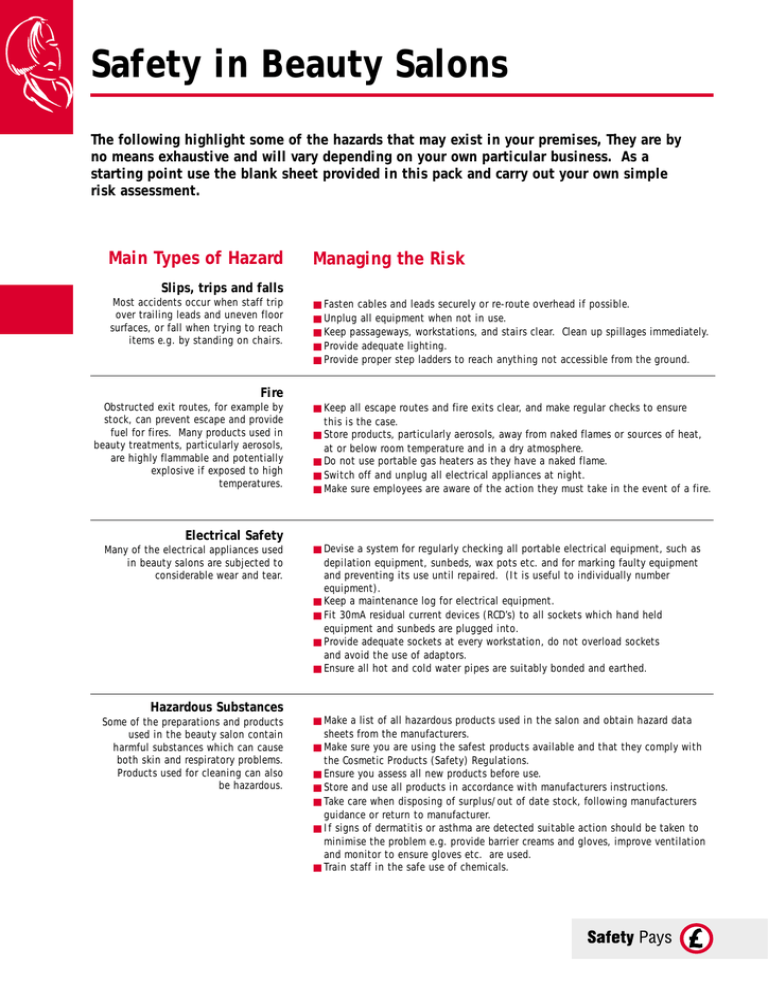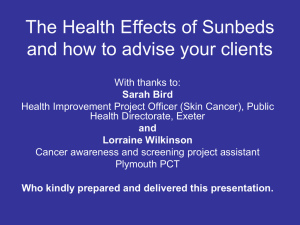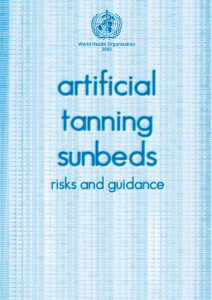Safety in Beauty Salons - Coleraine Borough Council
advertisement

Safety in Beauty Salons The following highlight some of the hazards that may exist in your premises, They are by no means exhaustive and will vary depending on your own particular business. As a starting point use the blank sheet provided in this pack and carry out your own simple risk assessment. Main Types of Hazard Managing the Risk Slips, trips and falls Most accidents occur when staff trip over trailing leads and uneven floor surfaces, or fall when trying to reach items e.g. by standing on chairs. ■ ■ ■ ■ ■ Fasten cables and leads securely or re-route overhead if possible. Unplug all equipment when not in use. Keep passageways, workstations, and stairs clear. Clean up spillages immediately. Provide adequate lighting. Provide proper step ladders to reach anything not accessible from the ground. Fire Obstructed exit routes, for example by stock, can prevent escape and provide fuel for fires. Many products used in beauty treatments, particularly aerosols, are highly flammable and potentially explosive if exposed to high temperatures. ■ Keep all escape routes and fire exits clear, and make regular checks to ensure this is the case. ■ Store products, particularly aerosols, away from naked flames or sources of heat, at or below room temperature and in a dry atmosphere. ■ Do not use portable gas heaters as they have a naked flame. ■ Switch off and unplug all electrical appliances at night. ■ Make sure employees are aware of the action they must take in the event of a fire. Electrical Safety Many of the electrical appliances used in beauty salons are subjected to considerable wear and tear. ■ Devise a system for regularly checking all portable electrical equipment, such as depilation equipment, sunbeds, wax pots etc. and for marking faulty equipment and preventing its use until repaired. (It is useful to individually number equipment). ■ Keep a maintenance log for electrical equipment. ■ Fit 30mA residual current devices (RCD’s) to all sockets which hand held equipment and sunbeds are plugged into. ■ Provide adequate sockets at every workstation, do not overload sockets and avoid the use of adaptors. ■ Ensure all hot and cold water pipes are suitably bonded and earthed. Hazardous Substances Some of the preparations and products used in the beauty salon contain harmful substances which can cause both skin and respiratory problems. Products used for cleaning can also be hazardous. ■ Make a list of all hazardous products used in the salon and obtain hazard data sheets from the manufacturers. ■ Make sure you are using the safest products available and that they comply with the Cosmetic Products (Safety) Regulations. ■ Ensure you assess all new products before use. ■ Store and use all products in accordance with manufacturers instructions. ■ Take care when disposing of surplus/out of date stock, following manufacturers guidance or return to manufacturer. ■ If signs of dermatitis or asthma are detected suitable action should be taken to minimise the problem e.g. provide barrier creams and gloves, improve ventilation and monitor to ensure gloves etc. are used. ■ Train staff in the safe use of chemicals. Manual Handling Lifting and moving stock and working at poorly designed workstations may cause back injury or muscular strain. ■ Avoid lifting items which are too heavy - use trolleys, lifts or other devices where possible. ■ Train staff in proper lifting techniques. ■ Design workstations to ensure staff have sufficient room to move around when working and provide chairs which can be adjusted depending on the size of the client and therapist. Hygiene There is risk of transmission of infection when using equipment and products on different clients. ■ Make sure ‘hard’ re-usable equipment such as tweezers and cuticle knives can be sterilised between use on clients by a glass-bead steriliser or an autoclave. NB. ‘Ultra-violet sterilisers’ DO NOT sterilise. Ultra violet light has disinfectant properties only. ■ Use disposable products where possible e.g. sterile disposable needles for electrolysis and orange sticks and emery boards for manicures, to avoid the need to sterilise such equipment between treatments. ■ Provide ‘sharps’ boxes for disposal of needles, blades etc. ‘sharps’ boxes should be disposed of by a registered waste carrier. ■ Use techniques which prevent cross contamination of creams, make-up products, wax pots etc. NEVER re-filter depilatory wax. ■ Thoroughly cleanse brushes, sponges, towels etc. between uses. ■ Contact your local council to register with them if you are carrying out skin piercing treatments such as electrolysis, acupuncture or ear piercing. Sunbeds There are recognised health risks associated with exposure to ultra-violet light. If the sunbed is not properly maintained there may be a risk of electric shock and fire. ■ Make sure the sunbed is regularly serviced and maintained. Keep maintenance records. ■ Make sure that the sunbed can be electrically isolated and that there is an emergency cut out switch provided for the client’s use. ■ Make sure that the sunbed has an effective timer fitted, and that there is a facility in the room for the client to summon assistance in the event of an emergency. The door of the room containing the sunbed should be capable of being opened from the outside should an emergency occur. ■ Train the staff about the hazards associated with ultra-violet light emitted by sunbeds and control their exposure to it in the working environment. ■ Keep records for each client, advise them of the health risks involved, and precautions they should take when using the sunbed. Give clients instruction on how the sunbed works, its safety features and the duration and maximum number of visits they should make each year. Provide advisory notices in the sunbed room. ■ Provide suitable eye protection for clients. Make sure that the sunbed and eye protection provided are thoroughly cleaned between use. ■ For further information: Code of Practice for Hygiene in Salons and Clinics The Federation of Holistic Therapists 38A Portsmouth Road Woolston Southampton Hampshire SO19 9AD Tel: 01703 422695 or contact your local council.




